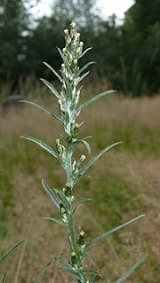
Gnaphalium sylvaticum
Encyclopedia
Gnaphalium sylvaticum, commonly known as wood cudweed and heath cudweed, is a weedy plant found in the North Temperate Zone. It was first formally described by Carl Linnaeus in 1753.
The plant is 8 to 60 cm tall.
The leaves are lanceolate in shape, pointed, 2 to 8 cm long, with a single vein
. They have no hair on top, but are whooly hairy below. The upper leaves become progressivley shorter and narrower.
The flower heads are 6mm long. The bracts of the flower heads have a green centre, and chaffy brown edges. The florets are pale brown. The achenes are hairy with reddish pappus
hairs.
If flowers from July until September.
Description
It is a perennial herb with short runners.The plant is 8 to 60 cm tall.
The leaves are lanceolate in shape, pointed, 2 to 8 cm long, with a single vein
Vein
In the circulatory system, veins are blood vessels that carry blood towards the heart. Most veins carry deoxygenated blood from the tissues back to the heart; exceptions are the pulmonary and umbilical veins, both of which carry oxygenated blood to the heart...
. They have no hair on top, but are whooly hairy below. The upper leaves become progressivley shorter and narrower.
The flower heads are 6mm long. The bracts of the flower heads have a green centre, and chaffy brown edges. The florets are pale brown. The achenes are hairy with reddish pappus
Pappus (flower structure)
The pappus is the modified calyx, the part of an individual disk, ray or ligule floret surrounding the base of the corolla, in flower heads of the plant family Asteraceae. The pappus may be composed of bristles , awns, scales, or may be absent. In some species, the pappus is too small to see...
hairs.
If flowers from July until September.

